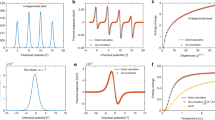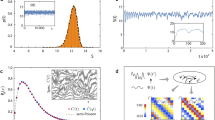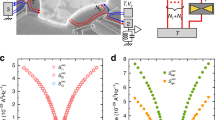Abstract
The entropy of an electronic system offers important insights into the nature of its quantum mechanical ground state. This is particularly valuable in cases where the state is difficult to identify by conventional experimental probes, such as conductance. Traditionally, entropy measurements are based on bulk properties, such as heat capacity, that are easily observed in macroscopic samples but are unmeasurably small in systems that consist of only a few particles1,2. Here, we develop a mesoscopic circuit to directly measure the entropy of just a few electrons, and demonstrate its efficacy using the well-understood spin statistics of the first, second and third electron ground states in a GaAs quantum dot3,4,5,6,7,8. The precision of this technique, quantifying the entropy of a single spin-1/2 to within 5% of the expected value of kB ln 2, shows its potential for probing more exotic systems. For example, entangled states or those with non-Abelian statistics could be clearly distinguished by their low-temperature entropy9,10,11,12,13.
This is a preview of subscription content, access via your institution
Access options
Access Nature and 54 other Nature Portfolio journals
Get Nature+, our best-value online-access subscription
$29.99 / 30 days
cancel any time
Subscribe to this journal
Receive 12 print issues and online access
$209.00 per year
only $17.42 per issue
Buy this article
- Purchase on Springer Link
- Instant access to full article PDF
Prices may be subject to local taxes which are calculated during checkout




Similar content being viewed by others
References
Ramirez, A. P., Hayashi, A., Cava, R. J., Siddharthan, R. & Shastry, B. S. Zero-point entropy in spin ice. Nature 399, 333–335 (1999).
Schmidt, B. A. et al. Specific heat and entropy of fractional quantum Hall states in the second Landau level. Phys. Rev. B 95, 201306 (2017).
Tarucha, S., Austing, D. G., Honda, T., van der Hage, R. J. & Kouwenhoven, L. P. Shell filling and spin effects in a few electron quantum dot. Phys. Rev. Lett. 77, 3613–3616 (1996).
Ciorga, M. et al. Addition spectrum of a lateral dot from Coulomb and spin-blockade spectroscopy. Phys. Rev. B 61, R16315–R16318 (2000).
Duncan, D. S., Goldhaber-Gordon, D., Westervelt, R. M., Maranowski, K. D. & Gossard, A. C. Coulomb-blockade spectroscopy on a small quantum dot in a parallel magnetic field. Appl. Phys. Lett. 77, 2183–2185 (2000).
Lindemann, S. et al. Stability of spin states in quantum dots. Phys. Rev. B 66, 195314 (2002).
Potok, R. M. et al. Spin and polarized current from Coulomb blockaded quantum dots. Phys. Rev. Lett. 91, 016802 (2003).
Hofmann, A. et al. Measuring the degeneracy of discrete energy levels using a GaAs/AlGaAs quantum dot. Phys. Rev. Lett. 117, 206803 (2016).
Cooper, N. R. & Stern, A. Observable bulk signatures of non-Abelian quantum Hall states. Phys. Rev. Lett. 102, 176807 (2009).
Ben-Shach, G., Laumann, C. R., Neder, I., Yacoby, A. & Halperin, B. I. Detecting non-Abelian anyons by charging spectroscopy. Phys. Rev. Lett. 110, 106805 (2013).
Smirnov, S. Majorana tunneling entropy. Phys. Rev. B 92, 195312 (2015).
Hou, C.-Y., Shtengel, K., Refael, G. & Goldbart, P. M. Ettingshausen effect due to Majorana modes. New J. Phys. 14, 105005 (2012).
Alkurtass, B. et al. Entanglement structure of the two-channel Kondo model. Phys. Rev. B 93, 081106 (2016).
Elzerman, J. M. et al. Single-shot read-out of an individual electron spin in a quantum dot. Nature 430, 431–435 (2004).
Ono, K. & Tarucha, S. Nuclear-spin-induced oscillatory current in spin-blockaded quantum dots. Phys. Rev. Lett. 92, 256803 (2004).
Landau, L. D. & Lifshitz, E. M. Statistical Physics 3rd edn 158–190 (Butterworth-Heinemann, Oxford, 1980).
Venkatachalam, V., Yacoby, A., Pfeiffer, L. & West, K. Local charge of the v = 5/2 fractional quantum Hall state. Nature 469, 185–188 (2011).
Field, M. et al. Measurements of Coulomb blockade with a noninvasive voltage probe. Phys. Rev. Lett. 70, 1311–1314 (1993).
Staring, A. A. M. et al. Coulomb-blockade oscillations in the thermopower of a quantum dot. EPL 22, 57 (1993).
Thierschmann, H. et al. Three-terminal energy harvester with coupled quantum dots. Nat. Nanotech 10, 854–858 (2015).
Beenakker, C. W. J. Theory of Coulomb-blockade oscillations in the conductance of a quantum dot. Phys. Rev. B 44, 1646–1656 (1991).
Gustavsson, S. et al. Electron counting in quantum dots. Surf. Sci. Rep. 64, 191–232 (2009).
Cockins, L. et al. Energy levels of few-electron quantum dots imaged and characterized by atomic force microscopy. Proc. Natl Acad. Sci. USA 107, 9496–9501 (2010).
Bennett, S. D., Cockins, L., Miyahara, Y., Grütter, P. & Clerk, A. A. Strong electromechanical coupling of an atomic force microscope cantilever to a quantum dot. Phys. Rev. Lett. 104, 017203 (2010).
Beckel, A. et al. Asymmetry of charge relaxation times in quantum dots: The influence of degeneracy. EPL 106, 47002 (2014).
Cronenwett, S. M., Oosterkamp, T. H. & Kouwenhoven, L. P. A tunable Kondo effect in quantum dots. Science 281, 540–544 (1998).
Hanson, R. et al. Zeeman energy and spin relaxation in a one-electron quantum dot. Phys. Rev. Lett. 91, 196802 (2003).
Zumbühl, D. M., Marcus, C. M., Hanson, M. P. & Gossard, A. C. Cotunneling spectroscopy in few-electron quantum dots. Phys. Rev. Lett. 93, 256801 (2004).
Szafran, B., Peeters, F. M., Bednarek, S. & Adamowski, J. In-plane magnetic-field-induced Wigner crystallization in a two-electron quantum dot. Phys. Rev. B 70, 235335 (2004).
Mittal, A., Wheeler, R. G., Keller, M. W., Prober, D. E. & Sacks, R. N. Electron–phonon scattering rates in GaAs/AlGaAs 2DEG samples below 0.5 K. Surf. Sci. 361–362, 537–541 (1996).
Acknowledgements
The authors acknowledge J. Martinis for a helpful discussion on the interpretation of our measurements. N.H., C.O., S.L., M.S. and J.F. were supported by the Canada Foundation for Innovation, the National Science and Engineering Research Council, CIFAR and SBQMI. S.F., G.C.G. and M.M. were supported by the US DOE Office of Basic Energy Sciences, Division of Materials Sciences and Engineering award no. DE-SC0006671, with additional support from Nokia Bell Laboratories for the MBE facility gratefully acknowledged.
Author information
Authors and Affiliations
Contributions
N.H. and C.O. fabricated the mesoscopic device. GaAs heterostructures and their characterization were provided by S.F., G.C.G. and M.M. S.L. and M.S. worked on early versions of the experiment and provided helpful discussion. N.H. performed measurements and analysed data. The manuscript was written by N.H. and J.F. with additional feedback from all authors.
Corresponding authors
Ethics declarations
Competing interests
The authors declare no competing interests.
Additional information
Publisher’s note: Springer Nature remains neutral with regard to jurisdictional claims in published maps and institutional affiliations.
Rights and permissions
About this article
Cite this article
Hartman, N., Olsen, C., Lüscher, S. et al. Direct entropy measurement in a mesoscopic quantum system. Nature Phys 14, 1083–1086 (2018). https://doi.org/10.1038/s41567-018-0250-5
Received:
Accepted:
Published:
Issue Date:
DOI: https://doi.org/10.1038/s41567-018-0250-5
This article is cited by
-
Optical readout of the chemical potential of two-dimensional electrons
Nature Photonics (2024)
-
Spin effects on transport and zero-bias anomaly in a hybrid Majorana wire-quantum dot system
Scientific Reports (2023)
-
Observing the universal screening of a Kondo impurity
Nature Communications (2023)
-
Entropic evidence for a Pomeranchuk effect in magic-angle graphene
Nature (2021)
-
Complete mapping of the thermoelectric properties of a single molecule
Nature Nanotechnology (2021)



